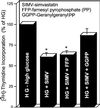3-Hydroxy-3-methylglutaryl CoA reductase inhibitors prevent high glucose-induced proliferation of mesangial cells via modulation of Rho GTPase/ p21 signaling pathway: Implications for diabetic nephropathy
- PMID: 12048257
- PMCID: PMC123062
- DOI: 10.1073/pnas.122228799
3-Hydroxy-3-methylglutaryl CoA reductase inhibitors prevent high glucose-induced proliferation of mesangial cells via modulation of Rho GTPase/ p21 signaling pathway: Implications for diabetic nephropathy
Abstract
Inhibitors of 3-hydroxy-3-methylglutaryl CoA (HMG-CoA) reductase, also known as statins, are lipid-lowering agents widely used in the prevention of coronary heart disease. Recent experimental and clinical data, however, indicate that the overall benefits of statin therapy may exceed its cholesterol-lowering properties. We postulate that statins may ameliorate the detrimental effects of high glucose (HG)-induced proliferation of mesangial cells (MCs), a feature of early stages of diabetic nephropathy, by preventing Rho isoprenylation. Rat MCs cultured in HG milieu were treated with and without simvastatin, an HMG-CoA reductase inhibitor. Simvastatin inhibited HG-induced MC proliferation as measured by [(3)H]thymidine incorporation. This inhibitory effect was reversed with geranylgeranyl pyrophosphate, an isoprenoid intermediate of the cholesterol biosynthetic pathway. At the cell-cycle level, the HG-induced proliferation of MCs was associated with a decrease in cyclin dependent kinase (CDK) inhibitor p21 protein expression accompanied by an increase in CDK4 and CDK2 kinase activities. Simvastatin reversed the down-regulation of p21 protein expression and decreased CDK4 and CDK2 kinase activities. Exposure of MCs to HG was associated with an increase in membrane-associated Ras and Rho GTPase protein expression. Cotreatment of MCs with simvastatin reversed HG-induced Ras and Rho membrane translocation. Immunofluorescence microscopy revealed that the overexpression of the dominant-negative RhoA led to a significant increase in p21 expression. Our data suggest that simvastatin represses the HG-induced Rho GTPase/p21 signaling in glomerular MCs. Thus, this study provides a molecular basis for the use of statins, independently of their cholesterol-lowering effect, in early stages of diabetic nephropathy.
Figures







References
-
- Maron D J, Fazio S, Linton M F. Circulation. 2000;101:207–213. - PubMed
-
- Pedersen T R. Am Heart J. 1999;138:177–182. - PubMed
-
- Harris K P, Purkerson M L, Yates J, Klahr S. Am J Kidney Dis. 1990;15:16–23. - PubMed
-
- Kasiske B L, O'Donnell M P, Cleary M P, Keane W F. Kidney Int. 1988;33:667–672. - PubMed
-
- Goldstein J L, Brown M S. Nature (London) 1990;343:425–430. - PubMed
Publication types
MeSH terms
Substances
Grants and funding
LinkOut - more resources
Full Text Sources
Other Literature Sources
Medical

